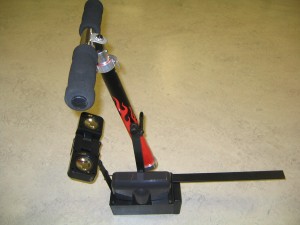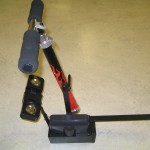Designers: Deep Mehtaji, David Zilber
Client Coordinator: Julie Auker, SLP, Durham Public Schools
INTRODUCTION:
Our client is a 14 year old boy with leukodystrophy. This is a neurological disorder in which the myelin sheath, which covers central nerve fibers, progressively degenerates. This results in a variety of symptoms, including the steady loss of body tone, gait, speech, vision, hearing, and behavior.
His speech therapist requested an activity that would help him understand the concepts of numbers and counting. The goal of this project was to create a counting game that was fun and motivating for the client, and also encouraged him to exercise in his wheelchair. The design must account for his visual and physical impairments so that he can use the device independently.

Figure 1: Photo of the device. It mounts to the client’s wheelchair by slipping the horizontal bar on the right side of the photo under the seat cushion. The client grabs the handles with both hands and pulls and releases the handlebar to count. The battery-powered circuitry is mounted in the black box at the bottom of the photo, and audio feedback is provided through the two speakers.
SUMMARY OF IMPACT:
Many individuals with disabilities cannot employ traditional means of learning due to spasticity, visual impairments, and other cognitive and physical disabilities. Our device employs rowing motion to convey the concept of quantity by counting the number of pull/push repetitions. The client’s mother commented that, “Jamison is able to use it easily and pulling the handle toward him works better than pushing. He laughs at the end of the counting when you say “Yea! You did it!”
TECHNICAL DESCRIPTION:
The Rowing Motion Counter teaches the client how to count by counting by one each time that the client pulls and releases a lever arm. It provides audible feedback of the current count. Figure 1 shows a photo of the device. The entire device is mounted on a 0.12 inch thick plate of steel which slides easily into a slot underneath the seat cushion on client’s wheelchair for quick installation / removal and portability. The lever arm was adapted from a scooter handlebar. It is connected to a residential door closer, which has an adjustable resistance so that the therapist can make it easier or harder for the client to pull the lever. A potentiometer is also connected at the axis of rotation to read the lever angle.
A Basic Stamp microcontroller (Parallax, Inc., Rocklin CA) controls the system operation. It samples the voltage of the potentiometer (which measures the position of the handlebar); this allows the device to determine when a full rowing motion (pull-release of the lever) was made by the client. By using the Stamp’s onboard clock, the device has a precise timing element, which becomes useful for pause operations. Audio feedback was implemented with the Rogue Robotics uMP3 player (Toronto, CA). Audio tracks are recorded into MP3 files and stored on a Secure Digital (SD) card, which provides easy access to audio files.
There are two operating modes for the device, selected by a switch. In practice mode, there is no desired target. As soon as the client begins to pull, the voice feedback announces the current iteration. When the client counts to 10, the device congratulates the client and the process is reset, allowing the client to start again from 1. If the client pauses for 5 seconds, the device will prompt him or her to keep going. In game mode, a target is randomly generated and announced upon activation of the device. The client must reach this value through successive strokes of the handlebar, and upon reaching the destination value; the client must either push the “engage” button or simply pause for 5 seconds. If this occurs, the device will congratulate the client, assign a new random value, and allow the client to start again. In the case that the client overshoots the target, the device will announce that the user has passed the target, and request the user to start from the beginning with the same target value. If the client pauses on a pre-target value, he or she will hear the prompt to keep going.
As the client matures, the resistance involved in pulling the handlebar can be easily adjusted by turning a screw, as the residential door closer has adjustability settings. The total cost of parts/materials was about $250.


University Operator: (919) 962-2211 | © 2024 The University of North Carolina at Chapel Hill |